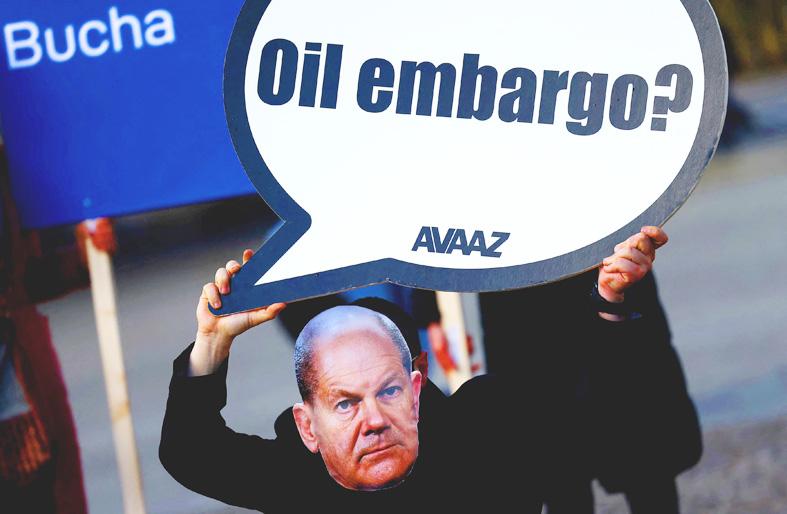Oil notched a weekly gain as traders weighed a global supply deficit, a potential ban on Russian oil from the EU and China’s latest COVID-19 lockdowns.
West Texas Intermediate (WTI) crude for May delivery on Friday gained US$2.70 to settle at US$106.95 per barrel, rising 8.8 percent for the week.
The June contract for the global benchmark Brent crude on Friday added US$2.92 to settle at US$111.70 per barrel. The contract rose 8.7 percent weekly.

Photo: Reuters
Oil rallied on Thursday afternoon after a report that the EU is moving toward adopting a phased-in ban on Russian oil.
Russian President Vladimir Putin earlier this week vowed to continue the invasion of Ukraine, pointing to a prolonged disruption of Russia’s energy exports.
Additionally, the International Energy Agency said in a report that OPEC+ members provided only 10 percent of their promised supply increases last month.
In the US, crude stockpiles jumped more than 9 million barrels last week, with over one-third of the build attributed to the shift of strategic oil reserves to commercial inventories. At the same time, most stocks of refined products fell, prompting a spike in so-called crack spreads — the rough profit from turning crude into fuel.
“Traders realize a good portion of that came from the strategic reserve, which now sets [sic] at 20 year inventory lows,” BOK Financial Corp senior vice president of trading Dennis Kissler said. “Crude storage remains 60.45 million barrels below the five-year average which should keep the buyers active on extreme sell offs.”
The oil market has seen a tumultuous period of trading since Russia invaded its neighbor in late February. A recent reserve release by the US and its allies, along with a virus resurgence in China, has weighed on prices in the past few weeks.
Yet there are some signs of easing COVID-19 restrictions and China’s central bank is expected to take measures to help bolster a faltering economy.
“Government energy intervention, the perceived self-shunning of Russian crude and the erratic buying patterns in recent weeks have all altered the near-term path,” RBC Capital Markets analyst Mike Tran said.
Trading looks “volatile and sloppy over the near term as the market digests the onslaught of 240 million barrels of crude unleashed from strategic reserves.”
To be sure, the market is still in the grips of a liquidity crunch sparked by surging volatility after a spike toward US$140. Open interest in WTI futures fell to the lowest since 2016 on Wednesday, while traders are using options strategies as a way of effectively raising cash in the face of limited sources of capital.
Elsewhere, Kazakhstan expects its main oil-export route via Russia to restore full operations late this month, the country’s energy minister said.
The nation said it remains concerned about the possible impact of Western sanctions or shipping issues on the flow of crude.
Additional reporting by staff writer

GROWING OWINGS: While Luxembourg and China swapped the top three spots, the US continued to be the largest exposure for Taiwan for the 41st consecutive quarter The US remained the largest debtor nation to Taiwan’s banking sector for the 41st consecutive quarter at the end of September, after local banks’ exposure to the US market rose more than 2 percent from three months earlier, the central bank said. Exposure to the US increased to US$198.896 billion, up US$4.026 billion, or 2.07 percent, from US$194.87 billion in the previous quarter, data released by the central bank showed on Friday. Of the increase, about US$1.4 billion came from banks’ investments in securitized products and interbank loans in the US, while another US$2.6 billion stemmed from trust assets, including mutual funds,

Micron Memory Taiwan Co (台灣美光), a subsidiary of US memorychip maker Micron Technology Inc, has been granted a NT$4.7 billion (US$149.5 million) subsidy under the Ministry of Economic Affairs A+ Corporate Innovation and R&D Enhancement program, the ministry said yesterday. The US memorychip maker’s program aims to back the development of high-performance and high-bandwidth memory chips with a total budget of NT$11.75 billion, the ministry said. Aside from the government funding, Micron is to inject the remaining investment of NT$7.06 billion as the company applied to participate the government’s Global Innovation Partnership Program to deepen technology cooperation, a ministry official told the

AI TALENT: No financial details were released about the deal, in which top Groq executives, including its CEO, would join Nvidia to help advance the technology Nvidia Corp has agreed to a licensing deal with artificial intelligence (AI) start-up Groq, furthering its investments in companies connected to the AI boom and gaining the right to add a new type of technology to its products. The world’s largest publicly traded company has paid for the right to use Groq’s technology and is to integrate its chip design into future products. Some of the start-up’s executives are leaving to join Nvidia to help with that effort, the companies said. Groq would continue as an independent company with a new chief executive, it said on Wednesday in a post on its Web

Taiwan Semiconductor Manufacturing Co (TSMC, 台積電), the world’s leading advanced chipmaker, officially began volume production of its 2-nanometer chips in the fourth quarter of this year, according to a recent update on the company’s Web site. The low-key announcement confirms that TSMC, the go-to chipmaker for artificial intelligence (AI) hardware providers Nvidia Corp and iPhone maker Apple Inc, met its original roadmap for the next-generation technology. Production is currently centered at Fab 22 in Kaohsiung, utilizing the company’s first-generation nanosheet transistor technology. The new architecture achieves “full-node strides in performance and power consumption,” TSMC said. The company described the 2nm process as